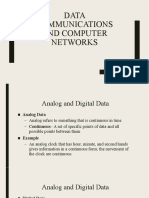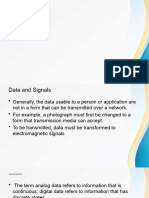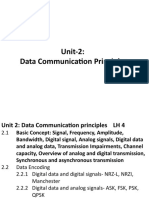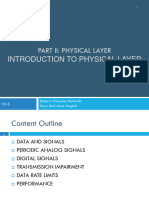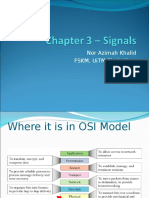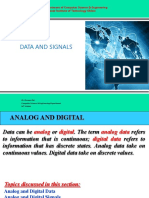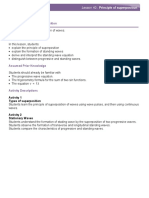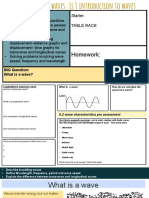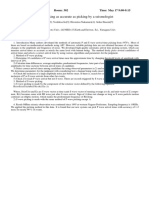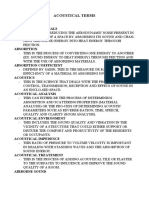8/23/2025
Computer Networks
PHYSICAL LAYER
Topics Data and Signal (Analog & Digital)
Analog and Digital Data
2
The term analog data refers to information that is continuous and digital
data refers to information that has discrete states.
To be transmitted, data must be transformed to electromagnetic signals.
Analog data is captured as continuous values. For instance, when someone
speaks an analog wave is created in the air. This can be captured by a
microphone and converted to an analog signal or sampled and
converted to a digital signal.
Digital data is captured as discrete values. For instance, data stored in
computer memory in the form of 0s and 1s. These can be converted to a
digital or modulated into an analog signal.
A. Biswas
1
� 8/23/2025
Analog and Digital Signal
3
• Like data, signals can also be either analog or digital.
• Analog signals can have an infinite number of values in a range.
• Digital signals can have only a limited number of values.
A. Biswas
Periodic and Nonperiodic Signal
4
Both analog and digital signals can take one of two forms: periodic or
nonperiodic (sometimes called aperiodic).
A periodic signal completes a pattern within a measurable time frame,
called period, and repeats that identical pattern over time.
A nonperiodic signal changes without exhibiting a pattern that repeats
over time.
In data communications, we commonly use periodic analog signals
and nonperiodic digital signals.
A. Biswas
2
� 8/23/2025
Periodic Analog Signals
5
Periodic analog signals can be classified as simple or composite.
A simple periodic analog signal, a sine wave, cannot be decomposed
into simpler signals.
A composite periodic analog signal is composed of multiple sine
waves.
A. Biswas
A sine wave: simple periodic analog signal
6
The sine wave is most fundamental form of a periodic analog signal.
A sine wave can be represented by three parameters: the peak
amplitude, the frequency and the phase.
A. Biswas
3
� 8/23/2025
Peak Amplitude
7
The peak amplitude of a signal is
the absolute value of its highest
intensity, proportional to the
energy it carries.
For electric signals, peak
amplitude is normally measured
in volts.
A. Biswas
Frequency and its relation with Period
8
Period refers to the amount of time (in seconds) a signal needs to
complete 1 cycle.
Frequency refers to the number of periods in 1second.
Note that period and frequency are just one characteristics defined in
two ways.
Period is the inverse of frequency, and frequency is inverse of period,
as the following formulas show:
A. Biswas
4
� 8/23/2025
Example: Two signals with the same amplitude and phase,
but different frequencies
9
A. Biswas
Units of Period and Frequency
10
Period is expressed in seconds and frequency is expressed in Hertz (Hz).
A. Biswas
5
� 8/23/2025
Phase
11
Phase describes the position of the waveform relative to time 0.
Phase is measured in degrees or radians.
A phase shift 3600 corresponds to a shift of a complete period.
A phase shift 1800 corresponds to a shift of one-half of a period.
A phase shift 900 corresponds to a shift of one-quarter of a period.
A. Biswas
Three sine waves with same amplitude and frequency, but
different phases
12
A. Biswas
6
� 8/23/2025
Analog signal in Time and Frequency Domain
13
A sine wave is comprehensively defined by its amplitude, frequency,
and phase.
So far we have shown sine wave in time-domain plot.
The time-domain plot shows changes in the signal amplitude with
respect to time (amplitude vs. time plot).
The frequency-domain plot is concerned with only peak value and the
frequency.
Changes of amplitude during one period is not shown in
frequency-domain plot.
A. Biswas
Time and Frequency domain plots of sine wave
14
A. Biswas
7
� 8/23/2025
Advantages of Frequency domain plot
15
The frequency domain is easy to plot and conveys the information
(peak amplitude and frequency) that one can find in the time domain.
We can immediately see the values of the frequency and peak
amplitude.
A complete sine wave is represented by one spike.
The position of the spike shows the frequency and its height shows the
peak amplitude.
Frequency domain is more compact and useful when we are dealing
with more than one sine wave.
A. Biswas
Time and Frequency domain of three sine waves
16
A. Biswas
8
� 8/23/2025
Composite Analog Signal
17
A single-frequency sine wave is not useful in data communications.
For instance, if we had only one sine wave to convey a conversation
over telephone, it would make no sense as we would just hear a buzz.
Therefore, we need to send a composite signal, a signal made of
many simple sine waves.
Any composite signal is a combination of many simple sine waves with
different frequencies, amplitudes, and phases.
A. Biswas
Periodic and Nonperiodic Composite Signal
18
A composite signal can be periodic or nonperiodic.
A periodic composite signal can be decomposed into series of simple
sine waves with discrete frequencies.
A nonperiodic composite signal can be decomposed into a combination
of an infinite number of simple sine waves with continuous frequencies.
A. Biswas
9
� 8/23/2025
Decomposition of Composite Periodic Signals in the Time
and Frequency domain
19
A. Biswas
Time and Frequency domains of Nonperiodic Signal
20
The signal created by telephone when words are pronounced.
A. Biswas
10
� 8/23/2025
Other Characteristics Analog Signals 1
21
Wavelength: It binds the period or the frequency of a simple sine wave to
the propagation speed.
Wavelength=propagation speed x period=propagation speed/frequency
A. Biswas
Other Characteristics Analog Signals 2
22
Bandwidth: The range of
frequencies in a composite signal is
its bandwidth.
The difference between the
highest and lowest frequencies
contained in a composite signal
gives the bandwidth of that signal.
A. Biswas
11
� 8/23/2025
23 Digital Signals
A. Biswas
Digital Signals
24
A digital signal refers to an electrical signal that is converted into a
pattern of bits.
For example, bit 1 can be encoded as a positive voltage and bit 0 as
zero voltage. This signal will have two levels.
A digital signal can have more than two levels depending on number
of bits needed in a level.
If a signal has L levels, each level needed log2L bits.
A. Biswas
12
� 8/23/2025
Two digital signals: one with two signal levels and the
other with four signal levels
25
A. Biswas
Bit Rate
26
The bit rate is the number of bits sent in 1second, and it is expressed in
bits per second (bps).
Example
Assume we need to download text documents at the rate of 100
pages per sec. What is the required bit rate of the channel?
Solution
A page is an average of 24 lines with 80 characters in each line. If we
assume that one character requires 8 bits (ascii), the bit rate is
100x24x80x8=1636000bps=1.636Mbps
A. Biswas
13
� 8/23/2025
Bit Length
27
The bit length is the distance one bit occupies on
the transmission medium.
Bit length=propagation speed x bit duration
A. Biswas
The time and frequency domains of periodic and
nonperiodic digital signals
28
If signal is periodic (very rare),
decomposed signal has discrete
frequencies in representation.
If signal is nonperiodic,
decomposed signal has
continuous frequencies.
Note that in both the cases
bandwidths are infinite.
A. Biswas
14
� 8/23/2025
Methods for Digital Signal Transmission
29
Digital signal can be transmitted by using two approaches: baseband
transmission and broadband transmission.
Baseband transmission means sending a digital signal over a channel
without changing the digital signal to analog signal.
Baseband transmission requires low-pass channel, a channel with a
bandwidth starts from zero.
Broadband transmission or modulation means changing the digital signal
to analog signal for transmission.
Modulation is the process of varying one or more properties of a periodic
waveform.
Modulation allows us to use bandpass channel, a channel with a
bandwidth that does not start from zero.
A. Biswas
Low-pass vs. Bandpass Channel
30
A. Biswas
15
� 8/23/2025
Baseband vs. Broadband Transmission
31
A. Biswas
16




